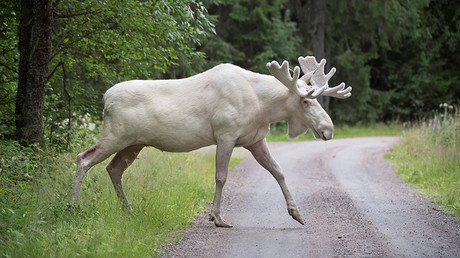Finnish media fall for ‘Soviet battle moose’ hoax, probed by regulator
The Finnish broadcaster Yle fell for a Russian April Fool’s prank and aired a report about the Soviet moose cavalry. Now it is being probed by the media regulator for failing to correct its mistake after finding out the story was bogus.
The original hoax was printed in the April 2010 edition of the Russian version of Popular Mechanics. The story claimed that Soviet Union in the 1930s ran a clandestine program to train moose as cavalry mounts and even had some 1,500 infiltration riders ready for the 1939 war with Finland. The magazine supported its joke with doctored photos of weaponized animals and a manual titled: “The use of moose in cavalry units of the Red Army”.
— Pekka Pekkala (@PekkaPekkala) November 24, 2017
The hoax dropped a number of hints for readers to catch, the ridiculous details including a claim that Stalin had postponed the start of the Finnish war to let the moose heat season pass, or that the animals could tell the Finnish language from Russian almost a kilometer away, and alert their riders to the presence of the enemy. The magazine even stated clearly that the story was a joke in the last paragraph.
The prank was so good that it recirculated as a true story in the Russian social media (and some media outlets) for several years. In June, Yle fell for it as well, with some Finnish newspapers reprinting its report. The blame apparently lies with a museum which used the photos printed by Popular Mechanics as part of its exhibition, much to the delight of the prank’s author. The Finnish broadcaster didn’t discover the blunder until a month later.
Now Yle is being investigated by Finland's media regulator, Council for Mass Media (JSN), over a complaint that it violated journalistic principles with the moose cavalry report. The complaint states that the channel failed to promptly correct its mistake and further accuses it of using photoshopped images in its original broadcast without informing viewers of the fact, Yle reported on Wednesday.
Moose were indeed domesticated in Russia, albeit not as mounts but rather as livestock – primarily for their milk and antlers. Moose milk is clamed to beneficial for people with stomach and intestine ulcers.
Moose cavalry is the stuff of legends. There are some mentions of the Mansi people in western Siberia riding moose with red-painted antlers into battle, but no evidence that it ever happened. Another story claims that Russian Empress Catherine the Great had banned domesticating the moose out of fear that the rebellious peasantry would use them after being exiled to Siberia.













